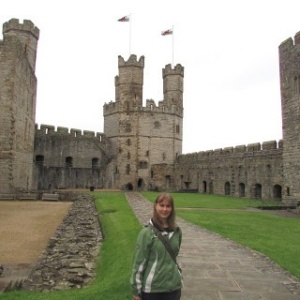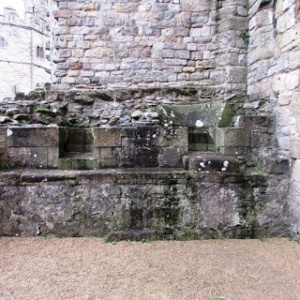Tuesday, May 21, 2013
Today dawned grey and cold, with mist that edged in and out of rain. It was not a morning to think about attempting the mountain, so Dad and I headed into Caernarfon (about a 15-minute drive from Llanberis) to visit Caernarfon Castle. Even in ruins, this structure dominates the town. I can only imagine what it must have been like when it was first built.
Caernarfon Castle
In 1272, Edward I became King of England while on crusade. His journey home took him through France, where he stopped in Paris to pay homage to King Philip for the lands he held in France; to his duchy of Gascony, where he stopped to deal with some Ducal business; and finally to England.
Like most of the Welsh princes before him, Llewellyn ap Gruffedd of Gwynedd refused to pay homage to the King of England. Unlike his predecessors, Edward I saw this as a slight and a threat to his reign; he began a campaign against the Welsh, culminating in the burning of the harvest on Anglesey (Llewellyn’s primary granary) and a Welsh surrender in 1277.
Peace was short-lived. In 1282-3 Llewellyn led a second campaign, including several embarrassing defeats for the English. Finally, in 1283, Edward I quashed the uprising, and began work on a ring of man-made fortresses that would encircle the natural fortress of the Snowdonia mountain range. His castles included Conwy, Flint, Harlech, and Caernarfon. Whereas the others were meant to be strictly military, Caernarfon Castle was meant to be a palace as well. Edward I’s heir was born in temporary quarters here in 1294, the castle still being under construction.
Caernarfon Castle was built in imitation of the castle described in the folk story “The Dream of Magnus Maximus,” found in the Mabinogion—a thirteenth-century collection of medieval Welsh legends, one of which is the basis for the historical fiction series I’m working on. Magnus Maximus, whom the Welsh called Macsen Wledig (pronounced Mac-sen oo-led-ic), was Emperor of Rome. In the story, he dreams of a far-off island with many mountains and streams, and a great castle with towers of various colours. Caernarfon has various coloured stones in its walls, and on its main tower are three stone eagles—the symbol of imperial Rome. It is said that Edward I deliberately drew on the Welsh love of Rome in creating his palace.
Despite its grand scale, Caernarfon Castle was never actually completed. The king’s gate (the main entrance) is missing several features, the Queen’s gate lacks its ramp, the kitchen’s never reached their full size, and there was to be an elaborate sea gate that was also never completed. It’s still impressive. Check out this picture of the stone cauldron supports; the cauldron would rest on the stones while a fire was lit beneath to heat it.
Included in the castle is the museum of the Welsh Fusiliers (a Welsh regiment dating back to 1689), which was really interesting, despite the lack of tactile things for me. My favourite bit of information from this site is that the Welsh language has been used to send coded messages, and has not yet been broken by enemy forces. It was successfully used against the Japanese during World War II, and again in 1995 against the Bosnians. This is making me reconsider my chances of teaching myself Welsh 😉
One Last Try for Snowdon
By the time we finished at Caernarfon Castle, it was starting to brighten, and the mist was slowly rising. We grabbed a bite to eat and headed back to our B&B for our boots and heavy coats. Then, at last, we began the walk up Snowdon. Unfortunately, by this time it was 2 in the afternoon, and we wasted a fair bit of time searching for the foot of the trail. Someone told us to head up this really steep road and, when we did, we found it led to a farmhouse—not up the mountain—so we wasted a fair bit of time back-tracking and searching for the actual start of the Llanberis Path. Could have done with some bigger sign posts! Between the lateness of the good weather and the misdirection, we simply didn’t have the time to get all the way up. I’m disappointed, but we did our best.
We still have one more day here in North Wales, but I’ve decided that if the weather is good I’d rather try to find Tre’r Ceiri again than to attempt Snowdon. Based on where I am in my writing, having an understanding of the layout of this hill fort and the countryside around it is more important. I regret leaving Snowdon undone, but I’ll be back to try again.
Tony Blackman, the late president of the Cornish Archaeological Society, always told me that you have to leave some things undone, because it gives you a reason to come back. I’ve got my reason: all 1000+ metres of it. Snowdon’s not going anywhere!


